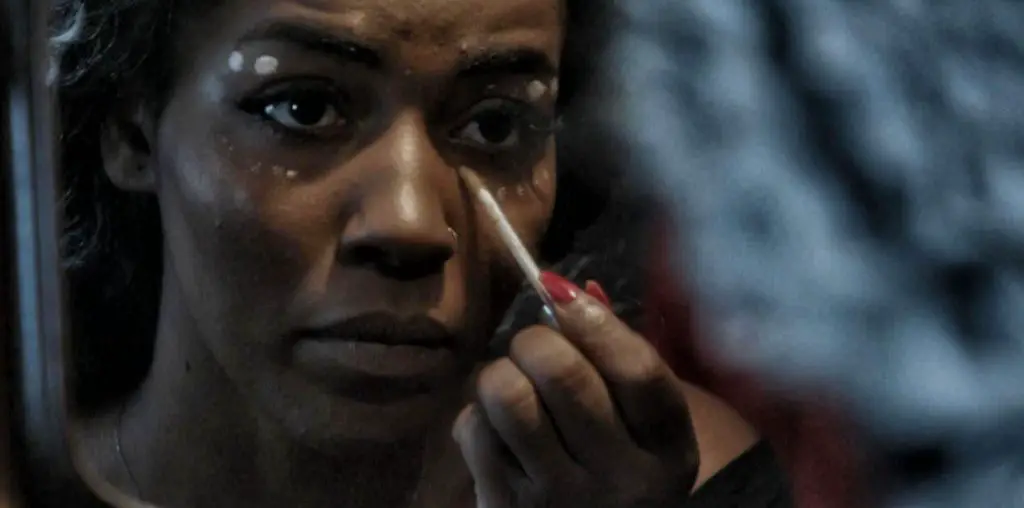
Mike Mignola’s comic book “Hellboy” tells the story of a demon, accidentally summoned to earth by Nazis, who ends up working as an investigator of strange phenomena for a shadowy government agency. The title has been a critical and fan favorite for over ten years, even if it’s flown under mainstream radar. Now, director and unabashed fan Guillermo del Toro has brought the character to life in a feature film. Del Toro no doubt hopes to heighten “Hellboy’s” profile with his movie, and judging by the finished product, I think that’s a likely possibility: “Hellboy” is as good a comic book flick as I’ve seen in years.
The film opens in 1944, as American troops close in on a ruined church where presumed stabbed/shot/poisoned Russian mystic Grigori Rasputin is attempting to lead the Nazis in summoning a creature from the outer dark that will turn the tide of World War II in Germany’s favor. The Nazis are foiled, but the portal was open long enough to summon a small, red, horned thing with a penchant for Baby Ruth bars. The troops name him “Hellboy” (for obvious reasons).
After the credits, we’re introduced to the now fully-grown Hellboy (Ron Perlman) – a surly adult with a prodigious appetite and a fondness for cats. There’s also Professor Bruttenholm (John Hurt) – witness to the events of 1944 and Hellboy’s surrogate father; Abe Sapien (Doug Jones, voiced by David Hyde Pierce) – half-man/half-fish with psychic abilities; and John Myers (Rupert Evans) – newly hired as Hellboy’s caretaker. They are all agents for the government’s Bureau of Paranormal Research and Defense (BPRD), the agency that “bumps back” against the things that go bump in the night, as Prof. Bruttenholm puts it.
Myers soon finds out what a handful his new charge can be. Hellboy beats feet after the first battle we see him fight in order to visit his would-be girlfriend, mentally disturbed pyrokinetic Liz Sherman (Selma Blair). This scene provides one of our first indications that “Hellboy” offers something more than the standard, spandex-clad superhero fare. Hellboy has genuine emotion for Liz, who in turn is too psychologically fragile to return the favor. The scenes between Perlman and Blair provide a nice counterpoint to the carnage taking place all around them. And, in fact, del Toro adroitly switches from moments of high comedy to those of real drama throughout the film, bringing together a number of disparate elements as the story unfolds.
Right, the story. It turns out Rasputin wasn’t actually killed in 1944 (he’s freaking Rasputin, baby), and he’s returned to complete his ritual. The BPRD follows him to Russia, battling his undead Nazi ninja assassin Kroenen and sundry other monsters until the final confrontation between the good guys and the insane mystic summoning outer gods.
“Hellboy” might also be one of the most satisfying Lovecraftian movies ever made. It starts with a quote from De Vermiis Mysteriis, shows us some elder things in the Void, and includes a nicely Cthulhoid boss monster. And while similarly themed films like “From Beyond” and Dagon have suffered from low budgets and lousy effects, del Toro brings big budget visuals to “Hellboy.” Granted, the title character isn’t too difficult to recreate, but the monsters are convincing enough, and Abe Sapien looks better on film than he does in the comic.
For those who haven’t forgiven Ron Perlman for “Beauty and the Beast,” get over it. Perlman is Hellboy, as proven by both del Toro and creator Mike Mignola making him their first choice. Perlman gets the sarcasm, the world-weariness, and the aching affection his character feels for Liz. Selma Blair looks good as Liz, and manages capably, but doesn’t stretch herself. I never personally thought of Abe Sapien as having David Hyde Pierce’s voice, though it works out well enough. Half the credit should go to Doug Jones, who has to try and convincingly portray a fish-man, and pulls it off remarkably.
With “Hellboy,” del Toro has pulled off two impressive directorial feats: he effectively mimics (Ha! Del Toro joke) the look of Mignola’s comic – from the colors to the panel style, and he also hews close enough to the source material to make rabid Mignola fans happy without bogging the non-comic reading viewer down in origin stories and playing catch-up. Looking at the upcoming slate of films for 2004, “Hellboy” just might end up being one of the best movies you see this year.
Disagree with this review? Think you can write a better one? Go right ahead in Film Threat’s BACK TALK section! Click here>>>
